From the exuberant spectacle of its Sing Sing festival to the flamboyant courtship dances of its iridescent-plumed birds of paradise, Papua New Guinea is the quintessential destination for adventure seekers and culture vultures alike.
My travels to wild and far-flung places can usually be traced to 2 culprits – National Geographic and BBC’s Nature documentaries. They have led me to the Galápagos, Peruvian, Brazilian and Ecuadoran Amazons, Madagascar, Tanzania, and Antarctica. So it’s not surprising that I eventually ended up in Papua New Guinea (aka PNG). Born from the haze of Nat Geo images in my childhood memory, I have long been fascinated by the country’s vibrant Sing Sing festival, while Sir David Attenborough’s TV episodes on the otherworldly mating dances of its biofluorescent birds of paradise – one of which seemed to be moonwalking, Michael Jackson style – guaranteed PNG a spot on my bucket list.
So what’s a Sing Sing? For some background, 1 million Stone Age inhabitants were living in isolation till Aussie prospectors broke through the jungles of the island’s central highlands in 1935. Head hunting and cannibalism were still practiced as recent as 50 years ago. In fact, Michael Rockefeller, John D. Rockefeller’s great-grandson, disappeared on an art collecting mission to PNG in the 60’s and was believed to have been killed and eaten by the largely uncontacted Asmat people.
PNG has 1000 different ethnic groups speaking 800+ languages. Until recently, the country’s incredibly diverse tribal culture has remained highly insular due to the island’s densely forested mountains and poor infrastructure. Many have their own traditional dance, often accompanied by chants and drums to celebrate major events or tell stories. In an effort to reduce tribal wars and blood feuds, the Sing Sing festival was started in the late 50’s as a government-sponsored social gathering, where warring groups can claim tribal superiority by out-singing rather than out-chopping rival clans. The success of the event led to Sing Sings in other regions over the years.
The Mount Hagen Sing Sing in the Western Highlands is one of the 2 biggest festivals in PNG. Up to 100 different tribal groups arrive by bus, truck, boat, or on foot for the festival spread over 2 days in an amazing spectacle of color, sound and bodies in motion. When I could finally find time to visit PNG for the Mount Hagen Sing Sing, I was super excited.
Of course, when I mention Papua New Guinea, 95% of people stare at me blankly – and for good reason. While I’m unfazed by travel advisories that warn of crime, civil unrest, unexploded ordnance, volcanic eruptions, and piracy in the waters around PNG, trying to visit the country is challenging in many ways. The densely forested mountainous interior has few roads, so unreliable commercial flights or pricey private charters are the main travel options. Also culturally, kin, village, and clan – in that order – take precedence in daily life. Since servicing the unknown tourist is a low priority task, it was crickets when I contacted guides for independent excursions. The few tourist grade hotels that do exist are reserved for group tours during the Sing Sing, so there was literally no room at the inn when I enquired… Batting zero on all counts, I finally turned to organized trips and found one from New Path Expeditions that offered a balanced mix of culture and birding.
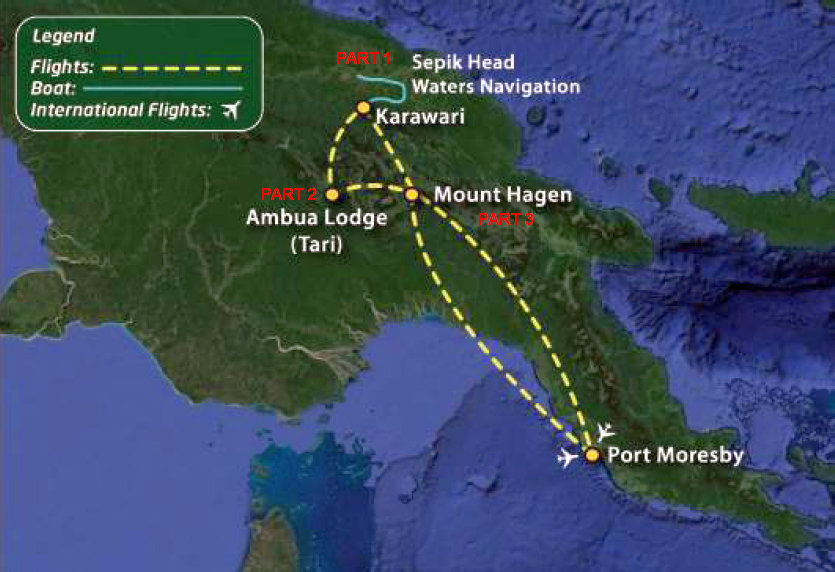
Outside Port Moresby, our group of 10 intrepid travelers met with our tour leader, Jorge Salas, who spent 2 decades visiting PNG, and is an honorary member of 2 clans. At our orientation meeting, Jorge stressed that travelling in PNG requires one to be flexible as things often don’t go as planned, and keep an open mind. It proved true time and again – from Day 0, when I arrived a day before the tour to find the hotel’s reservation manager claiming I didn’t have a reservation, despite her personally reconfirming my booking the week prior, to Day 1 when Jorge’s arrangement for special access to the National Museum fell through after his contact became ‘unavailable’, to cancelled guest lecture and village visit on different occasions due to the hosts’ reshuffled priorities… But by embracing the mantra ‘Expect the Unexpected’ and rolling with the punches, I was able to savor every moment, truly appreciating the rich cultural tapestry of a land like no other.
With few good roads connecting the country, our itinerary entailed 2 commercial and 3 charter flights, plus a stint in a river boat. This blog post (Part 1) covers our adventures as we headed for the northern-most reaches of our 14-day journey to explore the remote headwaters of the Sepik River, once the haunt of cannibals and headhunters…
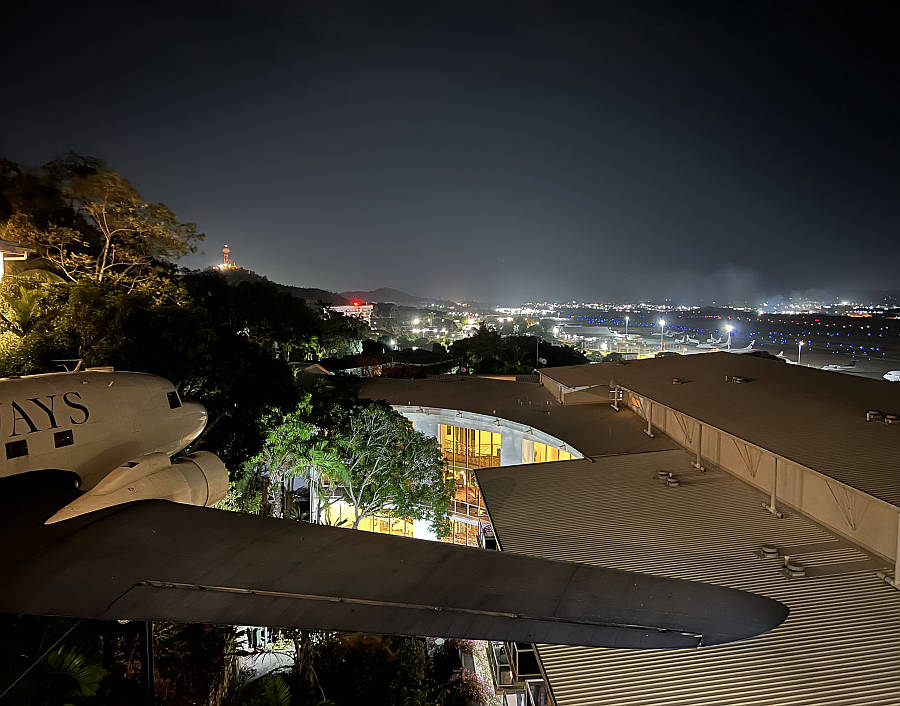
Port Moresby is deemed so unsafe that Jorge booked us into the Airways Hotel, just 5 minutes away from the airport. Lights of the capital twinkled in the distance, while a plane with AIRWAYS emblazoned on its fuselage parked quirkily, sans landing gear, on the hotel grounds.
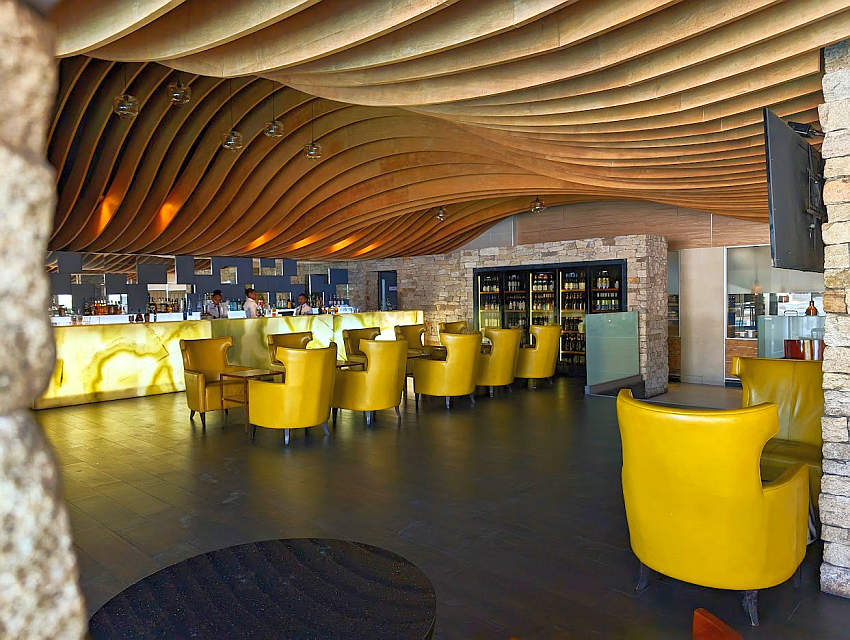
The backlit bar at Airways hotel sports a surprisingly hip vibe. Apparently, the hotel management updates the interiors on a periodic basis.
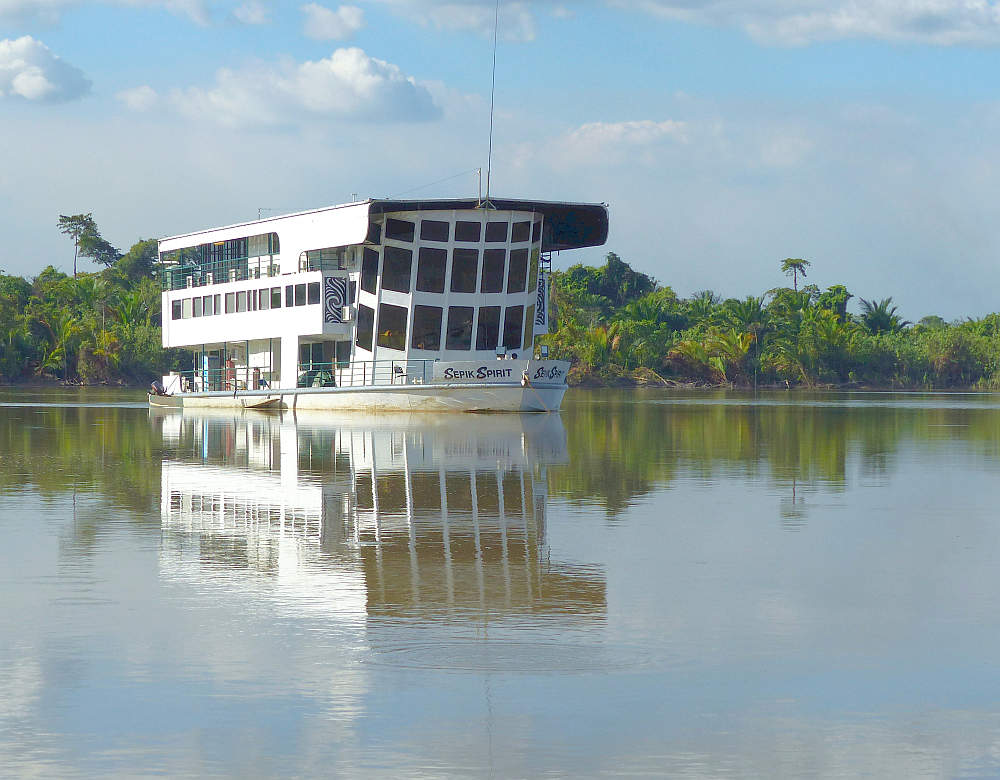
Our destination, the Sepik Spirit, was moored in the remote headwaters of the Sepik River. Reaching it required a commercial flight, private charter in the form of a 6-seater crop duster conversion, and lengthy speedboat ride. Designed to resemble the Haus Tambaran (Spirit House), a sacred traditional structure in the Sepik River region, this riverboat will be our home away from home for the next 3 days. Daily outings will be taken via jet boat.
Once on board, we were surprised by muddy water sputtering out from the faucets. Turned out mud somehow got sucked into the boat’s water filtration system. Sooo, Jorge gave the resident engineer a serious talking to. After a series of no water alternating with mud water, everyone was relieved the system magically cleared up after dinner. While the Sepik Spirit showcases a lot of beautiful indigenous carvings, it seriously needs a refurbishment. Unfortunately, being the only game in town, this is arguably the most ‘luxurious’ vessel plying the waters of the Sepik. What’s lacking in amenities is made up for by the helpful staff as they’re genuinely happy to accommodate any request. With running hot water and a quiet AC in my cabin, I’m GOOD!
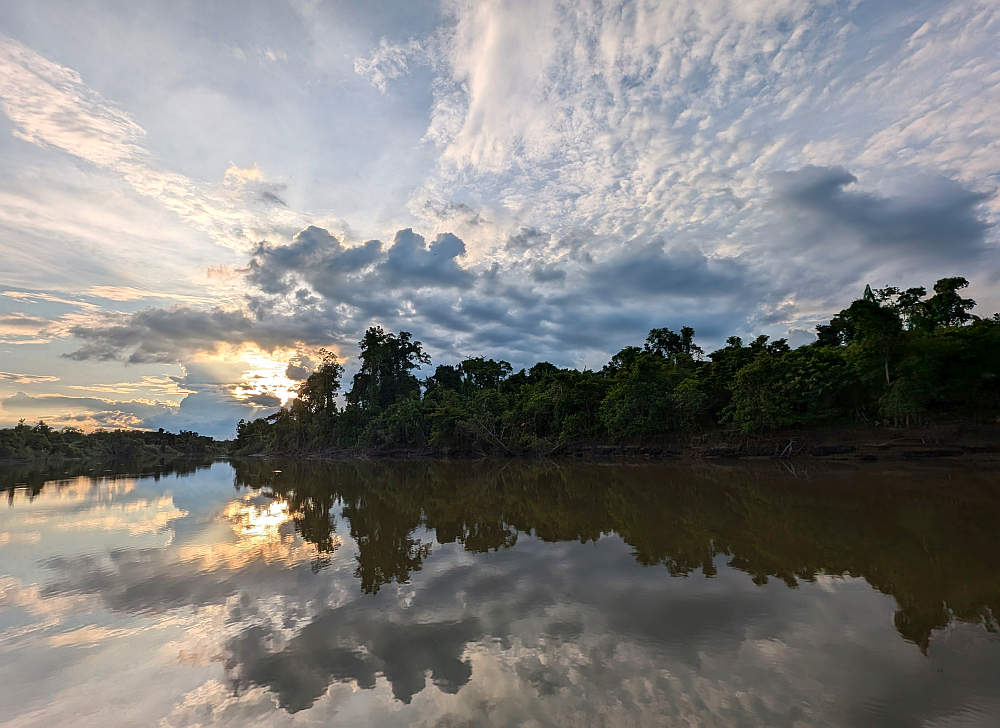
The default agenda for most days starts with some early morning birding. After breakfast often included 2 village visits, lunch, a village visit, birding excursion on lodge grounds, then a lecture on the cultural background of the next day’s activities by our native guide before we break for dinner. This dramatic sunset capped our first day on the Sepik River.
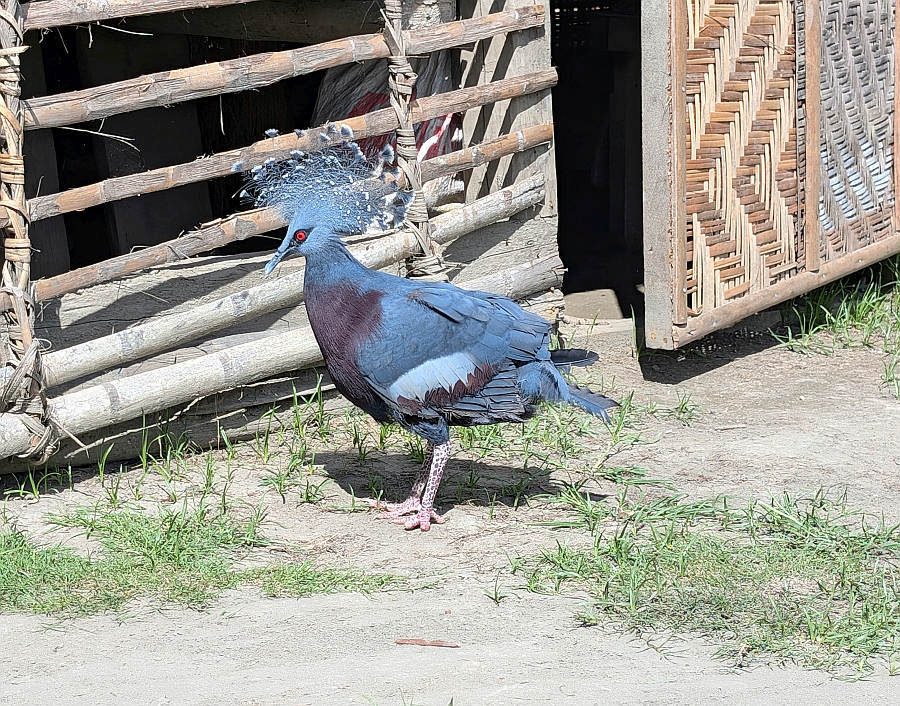
At the first village visit, a Victoria Crowned Pigeon and juvenile dwarf cassowary were roaming the grounds. They seemed to be pets – probably until the village needs some extra protein for a feast!
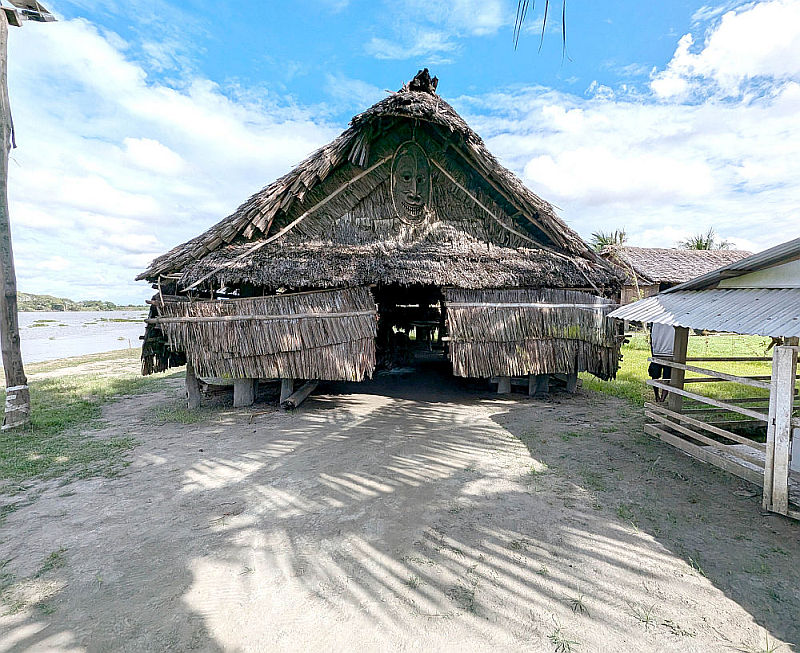
Every village has a Men’s House. It’s essentially a clubhouse for men to hang out and discuss current events, socialize, create wood carvings, handle political matters or sort out disputes, while the women tend to the daily chores.
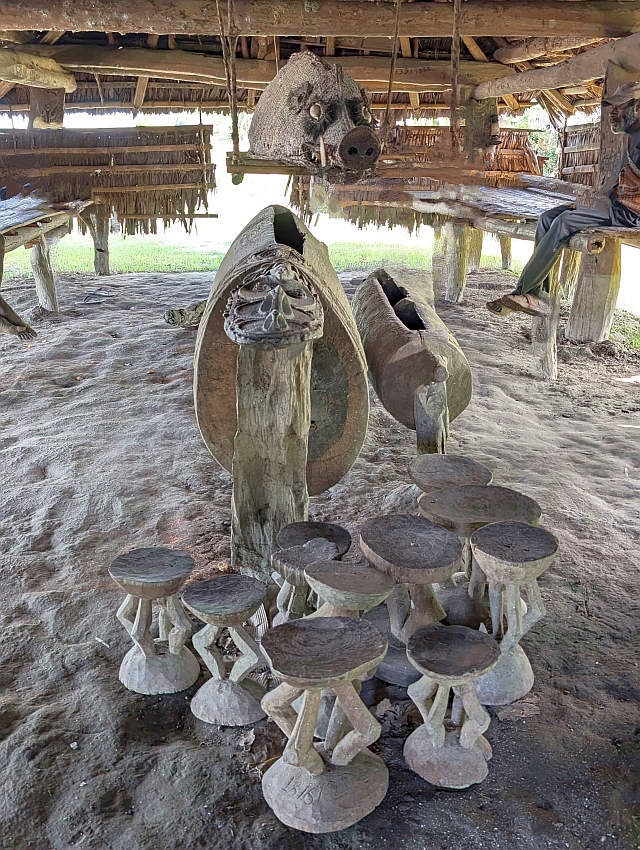
Inside the Men’s House, suspended from the rafter, is the carving of a pig, indicating the village is part of the Pig Clan. Clans in this region are typically totemic, as they associate themselves with a particular animal or natural element as their spiritual ancestor. Other major clans include: Crocodile, Cassowary, Eagle, and Snake.
Under the pig carving are 2 slit drums (Garamuts). The drum beats carry long distances and are used to send messages to the villagers out hunting or foraging. The big drum sports an elaborate crocodile carving replete with sharp pointy teeth.
At the feet of the drums are stools reserved for the village’s elders and leaders.
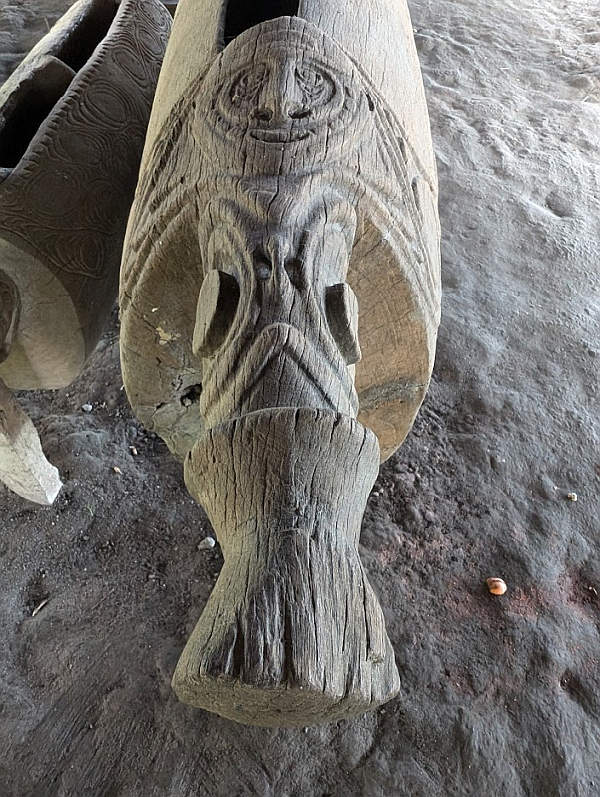
A pig head carving topped with a crocodile face adorns the large drum’s opposite end. At our prior night’s briefing, we learnt that pigs are a measure of wealth in PNG, much as cattle are to the Maasai and zebu to the Malagasy. At the same time, the crocodile is a popular motif as it’s the totem animal of the Sepik people, central to their beliefs and legends.
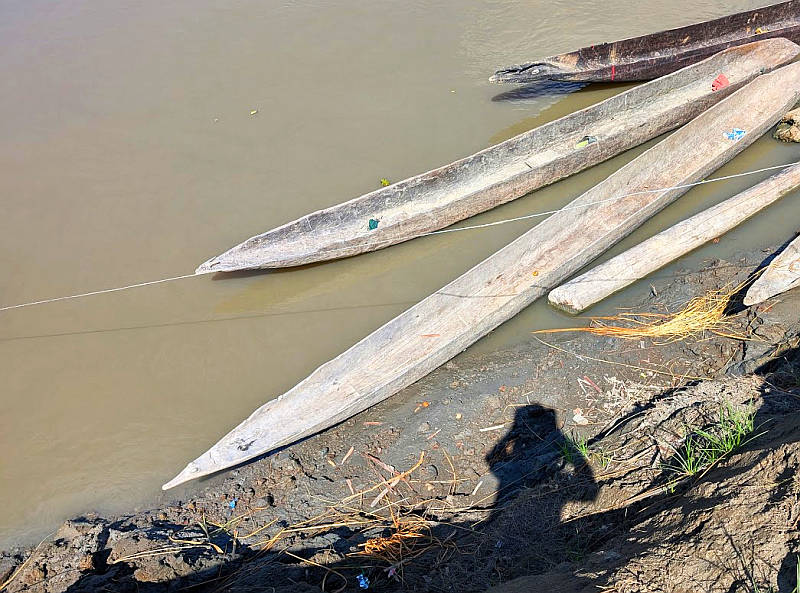
The river is the default highway in the Sepik Basin, so dugouts are the primary mode of transport. A young man must learn how to make one before he can get married, as he will be responsible for making a dugout canoe for every member of his family. With every family having a couple of dugouts, the river bank can get crowded.
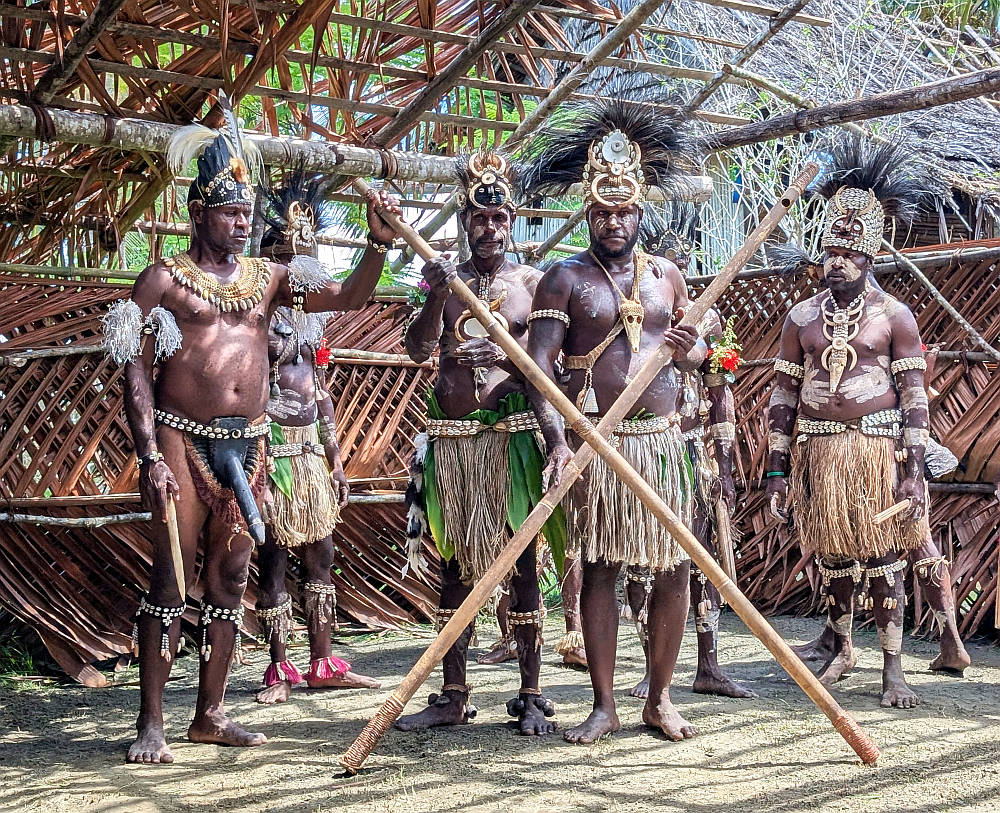
At the next village, we were treated to a Long Flute duet. Bamboo flute playing is passed down through generations, and remains a part of the traditional rites. Sadly, its popularity is waning and these 2 brothers are the only players left in the area with such skills.
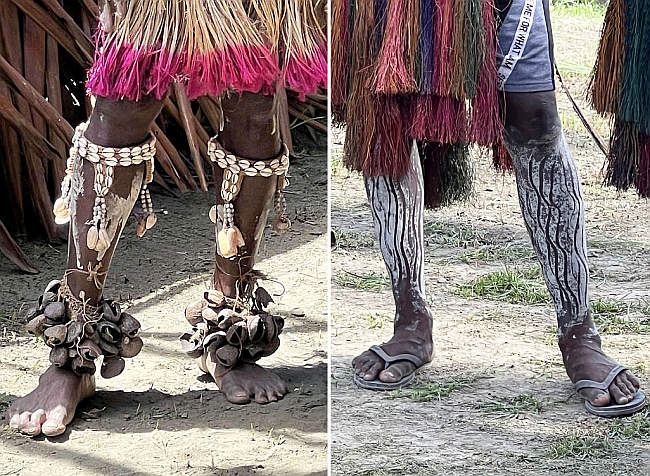
It’s our understanding that when guests, tourists or otherwise, visit a village, it’s the norm for the villagers to welcome them with decorum, dressed in bilas. Bilas is the entire ensemble of traditional body adornment that includes intricate headdresses, clothing, body paint, jewelry and accessories. Crafted from a wide array of materials, such as feathers, human hair, shells, tusks, seeds, raffia, ash or clay, it’s worn during Sing Sings and important social gatherings. Each pattern created by a specific combination of materials signals the wearer’s clan, social status, wealth, and ancestry. To its people, the bilas is neither purely decorative nor just a costume, but intended to amplify a person’s spiritual identity. It is believed that wearing the full bilas invites ancestral spirits to enter the wearer, blurring the line between the physical and spiritual worlds. As can be seen here, leg decorations can range from fanciful shell bands to body paint with ash.
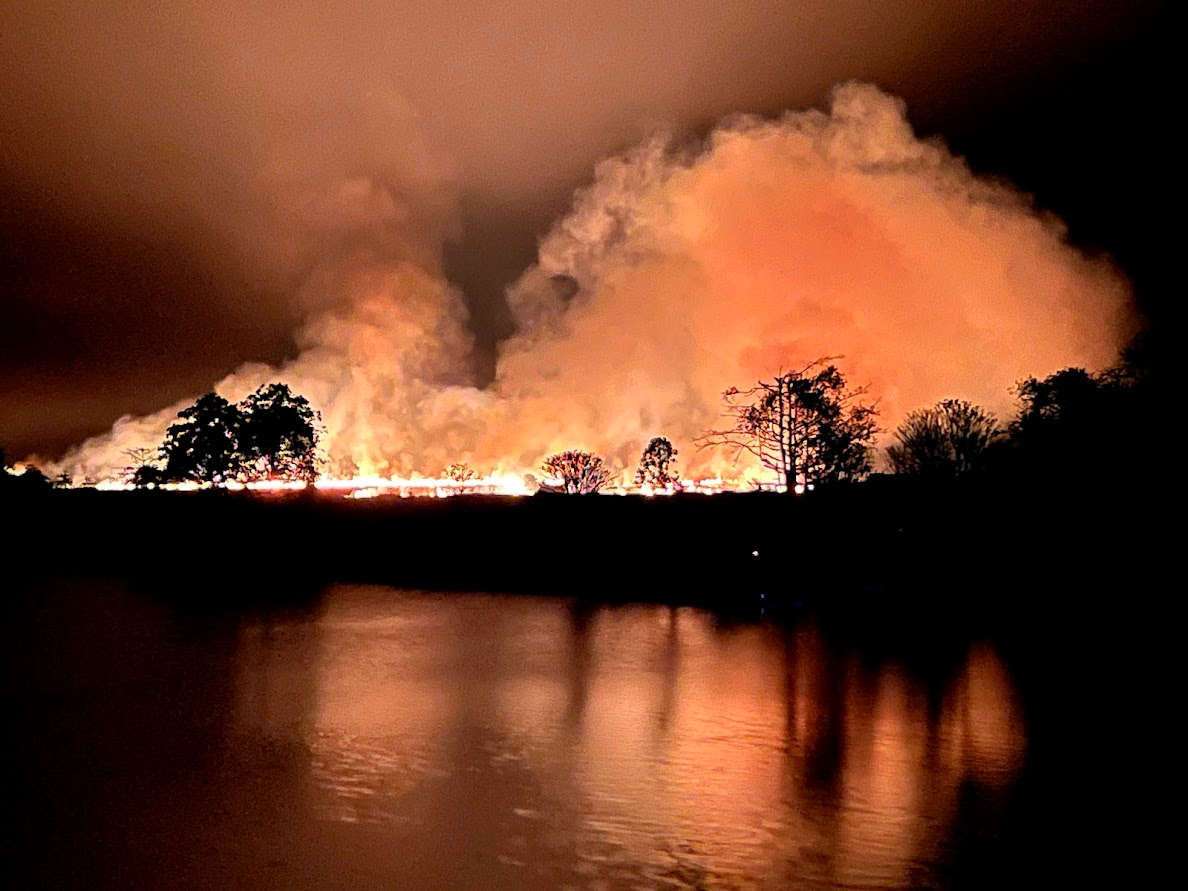
Most villages practice slash-and-burn agriculture. That night we saw a controlled burn on the banks of the river as villagers cleared the vegetation for planting crops.
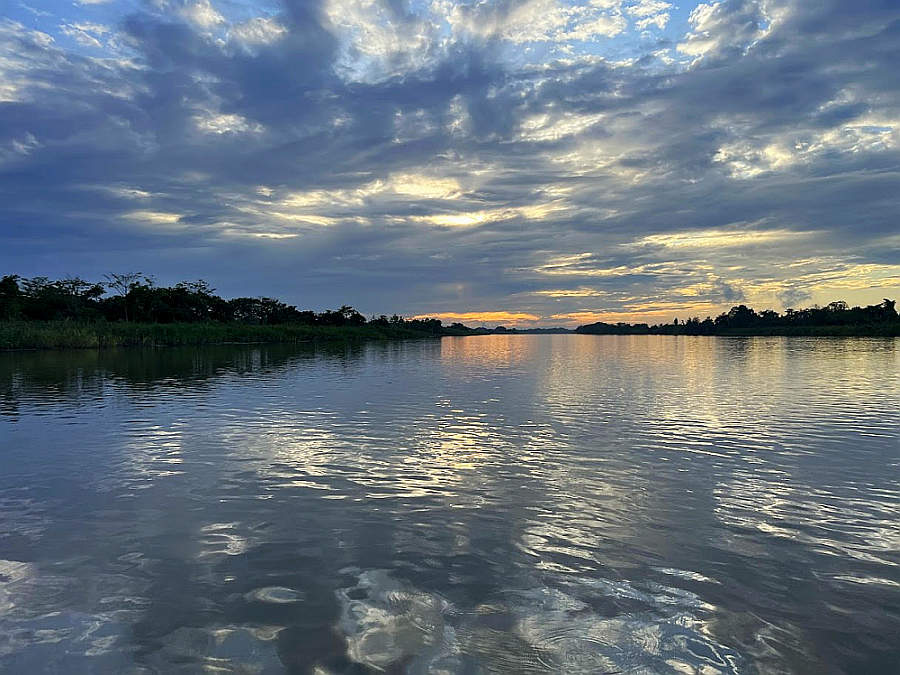
While birding at 6:45 am from a boat is not exactly productive for a large variety of reasons, at least there was a beautiful sunrise.
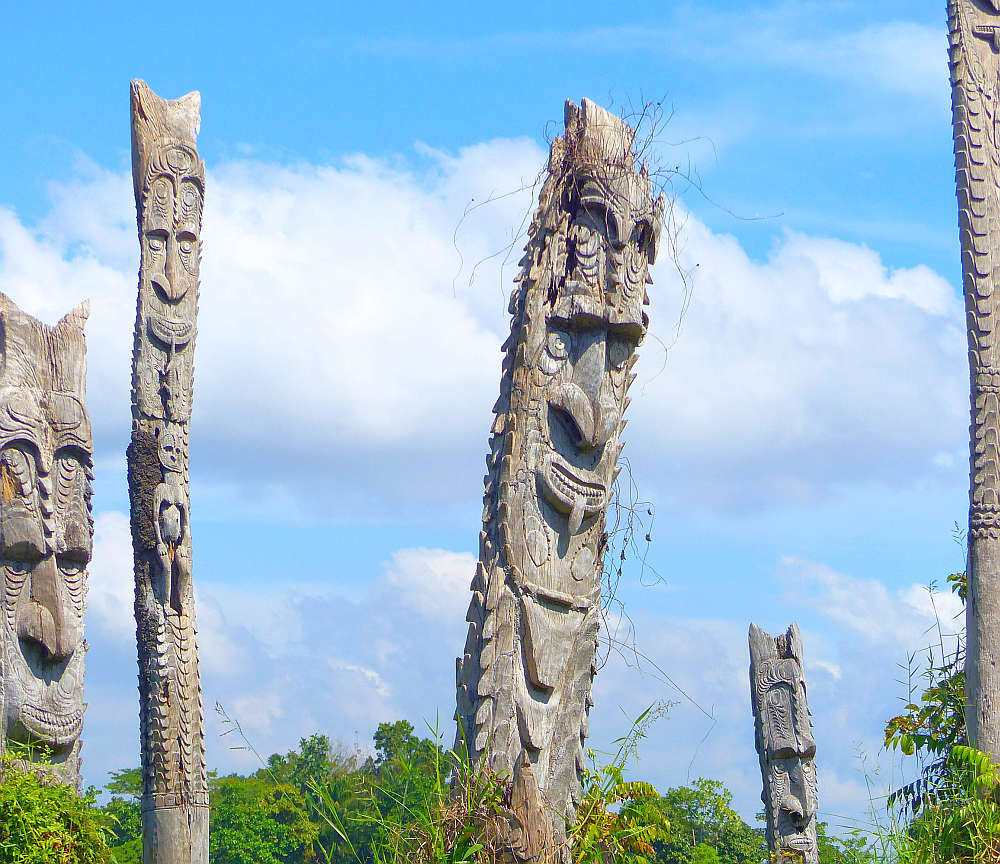
The day’s highlight was the much anticipated visit the Crocodile People, where the reptile is worshipped as an ancestral spirit, and body scarification is still practiced in initiation rites. As we approached the village, the towering crocodile totems stared down on us menacingly.
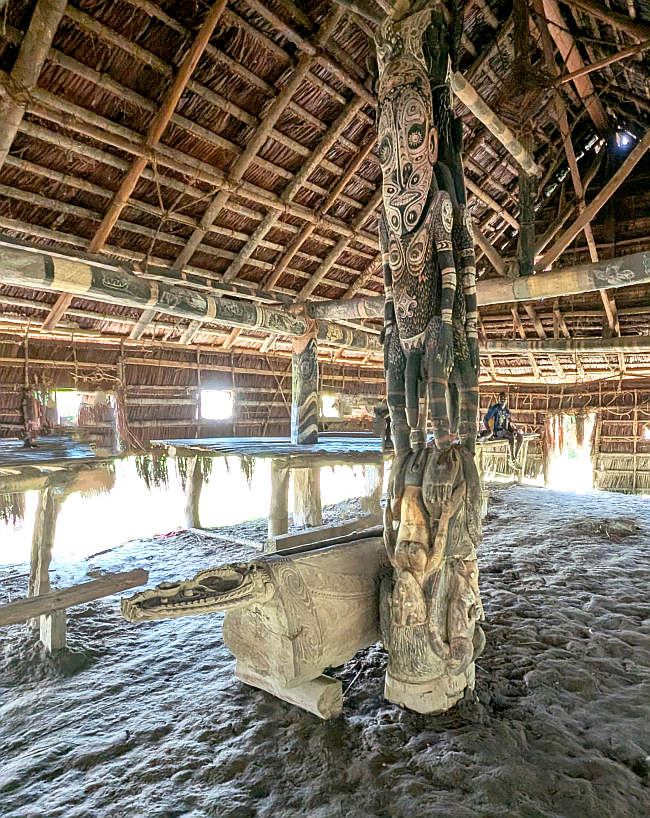
This large, elaborately embellished structure is the fabled Spirit House. Spirit Houses are where the villagers’ ancestral spirits – believed to reside in each clan or family’s totems – are kept. It’s also where rituals such as initiation scarification are practiced, and headhunter ‘trophies’ are displayed. Back in time, when this was a headhunting village, ‘trophies’ used to be encased in mud and placed in the openings of the Spirit House to show warrior prowess and invoke protection for the community.
We learnt that in many villages the Spirit House and Men’s House are part of a two-story building, usually with the Spirit House on the 2nd floor, since women and children are strictly forbidden from entering or seeing the interior of the Spirit House. But there are also villages that have separate, one-story buildings for either the Men’s House or Spirit House. Many villages do not have Spirit houses anymore, due to the influence of missionaries.
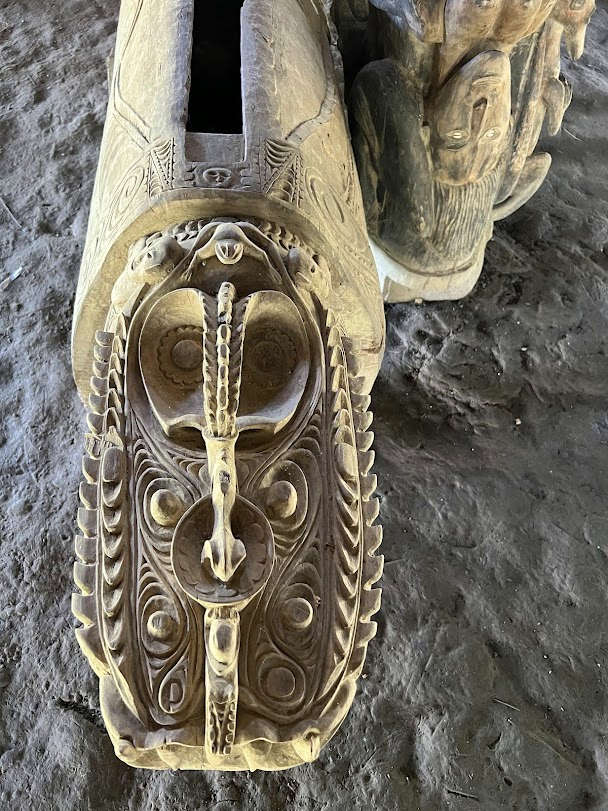
The crocodile is a central creator being, an ancestral spirit that represents strength, power, and the origin of the Sepik people. The large slit drum is decorated with an intricately carved crocodile head.
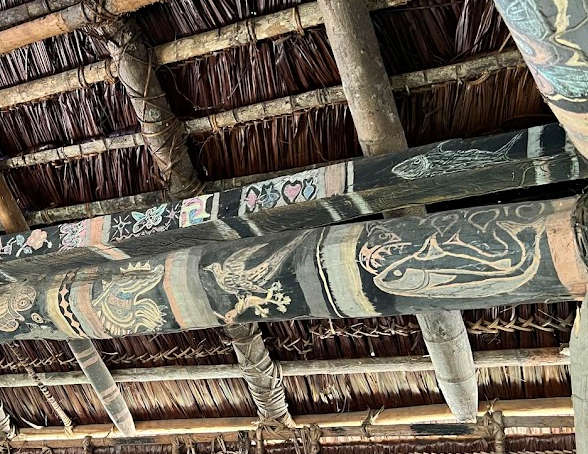
Spirit House rafters bedecked with colorful drawings of native flora and fauna.
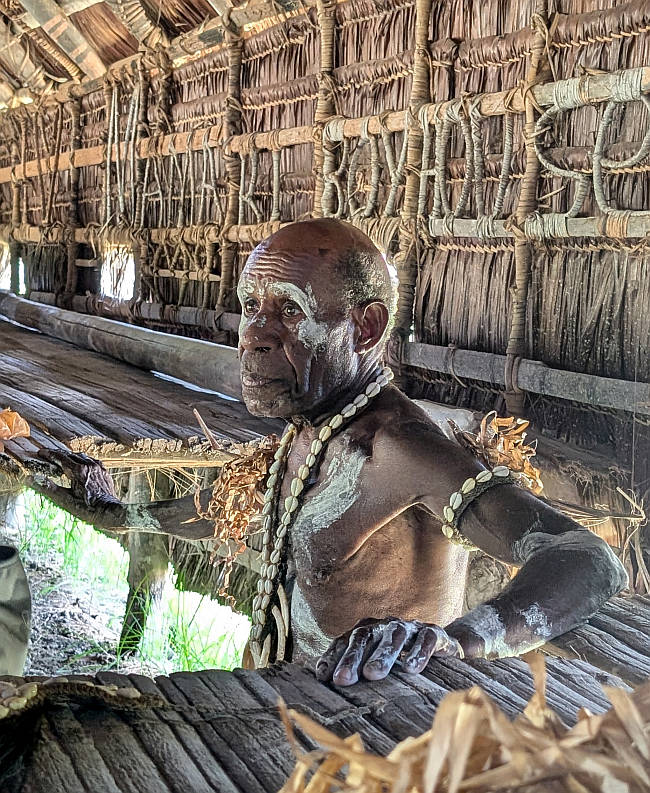
Looking pensive, a village elder waited for the group to assemble outside for the Victory Dance.
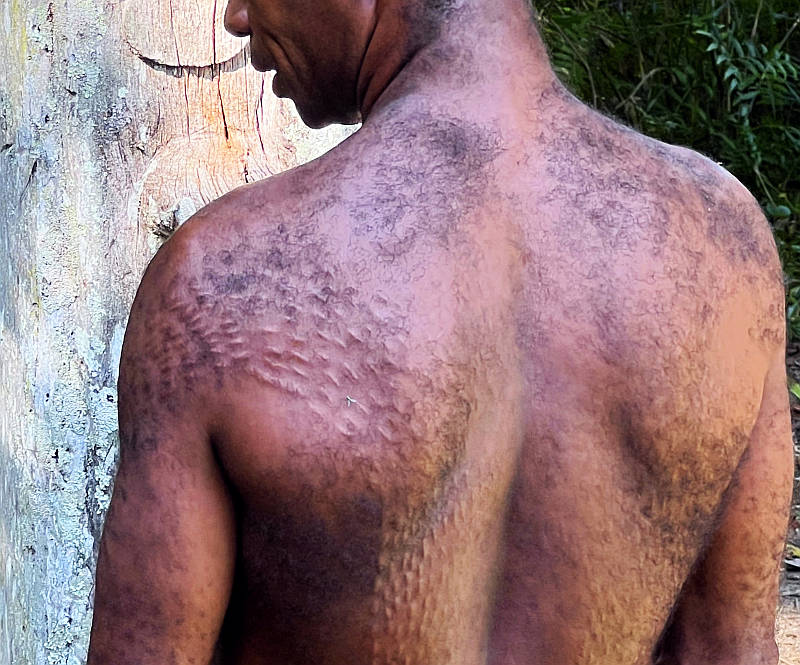
The Crocodile People in the Sepik region believe they descended from crocodiles, and practice an initiation ritual to physically and spiritually mark their transformation to manhood. Boys and young men aged between 11 to 30 are sequestered in the Spirit House for 1-3 months and taught tribal history, endurance, and discipline. The scarification ceremony takes weeks and involves making hundreds of cuts on the initiates’ back, chest, and shoulders to resemble the scutes (bumpy scales) on a crocodile’s skin. The wounds are treated with a mixture of oil, river mud and clay to promote scarring. At the end of the process, the initiates emerge bearing raised power and skeloid scars, symbolizing their rebirth as Crocodile Men, possessing their ancestors’ power and strength.
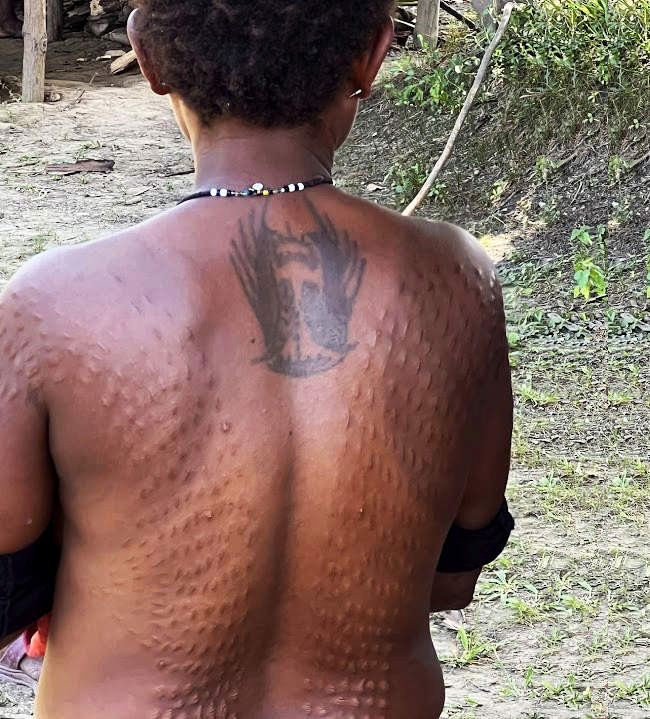
There was a young woman at the village who also went through the ritual, and Jorge said it’s the first time he’s seen scarification on a woman!
The following morning, we bade farewell to the Sepik Spirit and eagerly headed for our next stop: the Karawari Lodge in the Karawari Basin, where cannibals once stalked the land…


